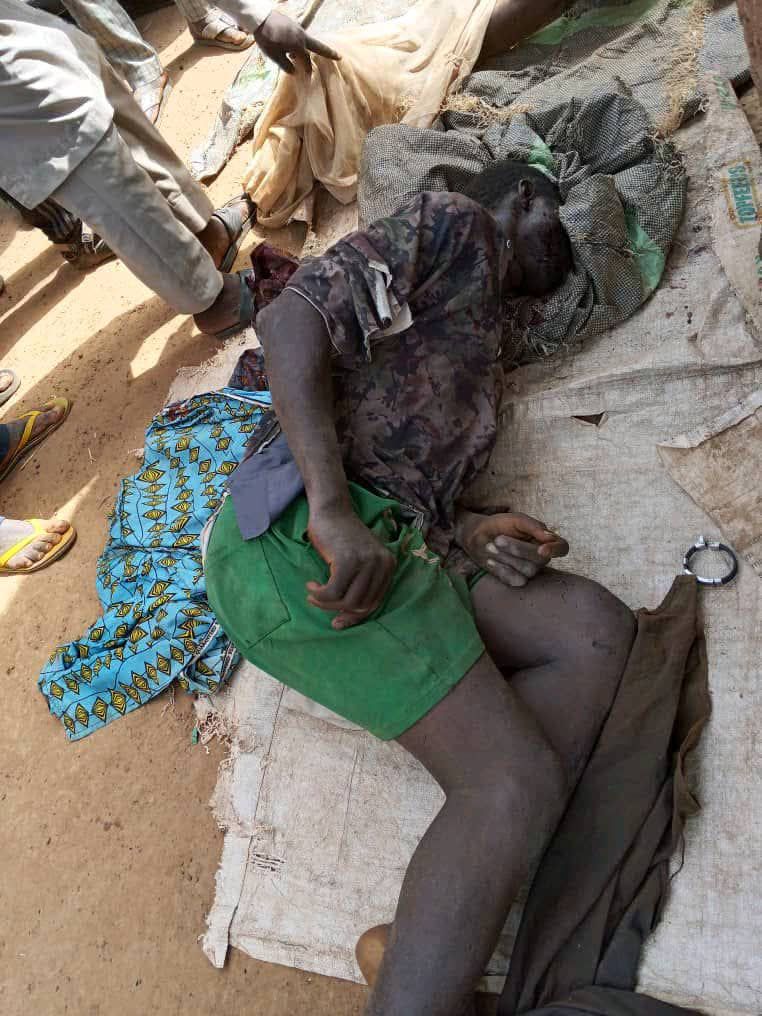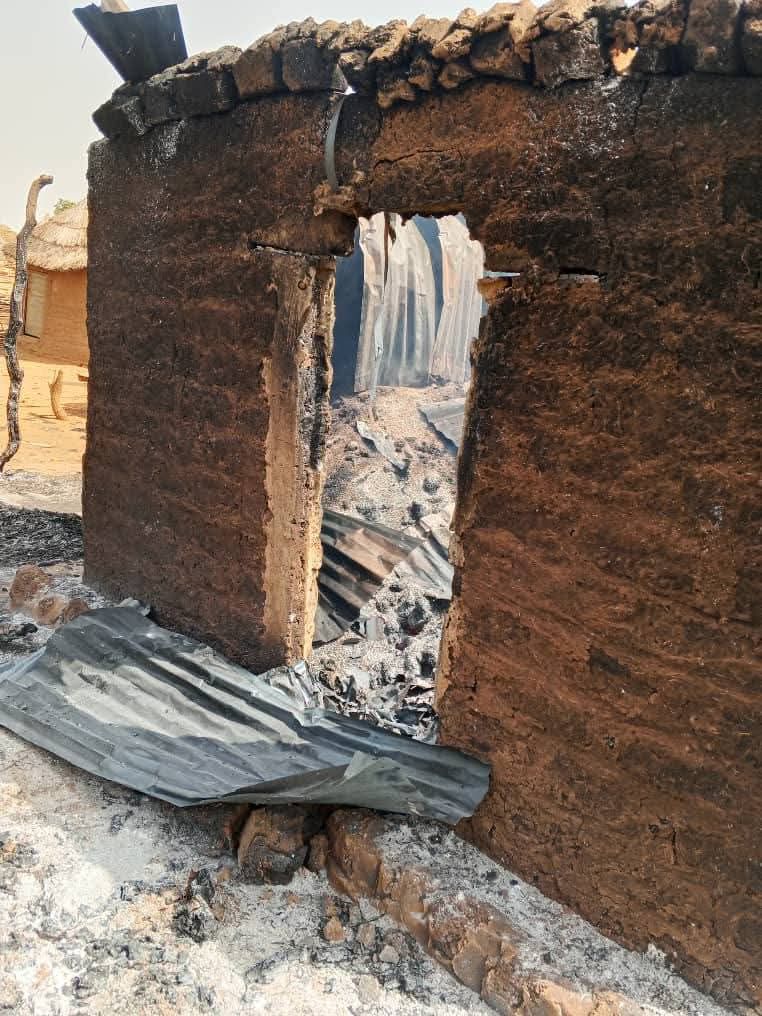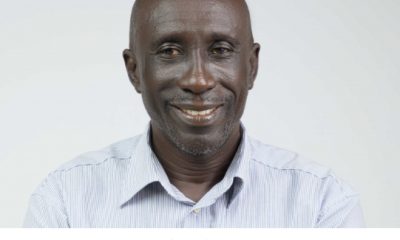News
RE: TWO ARMY OFFICERS ALLEGEDLY DETAINED MAN OVER DEALING WITH SOLDIER GIRLFRIEND

RE: TWO ARMY OFFICERS ALLEGEDLY DETAINED MAN OVER DEALING WITH SOLDIER GIRLFRIEND
By: Sani Uba
Attention of the Headquarters Training and Doctrine Command Nigerian Army (TRADOC NA), has been drawn to an unsubstantiated allegation published against the image of the command by an online media outlet (INDEPENDENT NIGERIA) on Wednesday 16 October, 2024.
The report alleged that some officers of TRADOC NA connived, arrested and detained a civilian on the ‘Orders of the Commander ‘, over suspicion that he wanted to defraud a food vendor who was also a girlfriend and business partner to the man.
While Headquarters TRADOC NA would want to refrain from engaging with such groundless claims, it is important to address the misinformation that seeks to undermine the integrity of both TRADOC NA, its leadership and the entire personnel of the command.
It is essential to set the records straight as to what transpired between Miss Lynda Moses (one of the food vendors in TRADOC Officers Mess) and the man Deekae Sunday Kiaka (a dismissed NAF personnel) of the Nigerian Airforce Base in Minna.
Investigation revealed that Miss Lynda Moses had reported a case to the Military Police (MP) in Minna Military Cantonment sometimes in September 2024 of theft against one fake Sgt Deekae Sunday of the NAF Base in Minna. She alleged that the sum of N1.1 million was withdrawn from her First Bank Account.
On receipt of the case, the MP was able to arrest the suspect on 6 October, 2024 since the offence was committed in Minna Cantonment when the suspect visited the victim at her business place. Upon investigation it was discovered that the accused was a dismissed personnel of the NAF Minna. Investigation further revealed that the accused has been impersonating as a serving ‘Sgt’ in the NAF whereas had since been dismissed from the NAF over a similar fraudulent crime in the past.
The suspect further averred that on the said date (25 September, 2024), he came to TRADOC officers’ Mess to see Miss Lynda Moses where he requested for her mobile phone to play game, to keep himself busy while Lynda was attending to her customers at her sales point in TRADOC Mess.
During interrogation, the suspect pleaded that the matter should be resolved by MP in Minna Military Cantonment and should not be taken to Nigerua Police Force ( NPF ) . He wrote an undertaking to refund the stolen money while the MP asked him to get a surety to perfect the undertaking. The accused requested that his cellphone should be given to him to call someone (who turned out to be another of his fiancé), one Miss Chiwendu Nnadozie, a reporter of Daily Independent in Niger State.
When Miss Chinwendu Nnadozie was invited at MP office in the Cantonment, she introduced herself as fiance to the accused and accepted to stand as a surety to the accused. The acceptance of Miss Chinwendu Nnadozie confirmed that the accused was double dealing in terms of marriage, promised to marry the two ladies at the same time.
These allegations represent a calculated attempt by a felon to deliberately tarnish the good reputation of TRADOC NA and its leadership.
We expected the media outlet (Independent Nigeria) to have thoroughly verified the claims before publication as well as adhering to journalistic ethics, as this unprofessional conduct could be a huge disappointment to journalism profession. On completion of the ongoing MP investigation, the case will be handed over to the NPF for possible prosecution.
As we work together towards achieving the security, peace and development of our beloved nation, we expect all personnel of TRADOC NA which is the centre of excellence for NA towards building the capacity and resourcefulness of the NA personnel to maintain discipline and are encouraged to sustain their unalloyed commitment in achieving the objectives of the command.
RE: TWO ARMY OFFICERS ALLEGEDLY DETAINED MAN OVER DEALING WITH SOLDIER GIRLFRIEND
News
EXCLUSIVE: expanding JAS/ANSARU–JNIM violence signals growing jihadist threat in Niger–Kwara corridor

EXCLUSIVE: expanding JAS/ANSARU–JNIM violence signals growing jihadist threat in Niger–Kwara corridor
By: Zagazola Makama
Recent attacks by terrorists linked to Jama’atu Ahlis Sunna Lidda’awati wal-Jihad (JAS), Ansaru splinter factions and the Jama’at Nusrat al-Islam wal-Muslimin (JNIM) have brought into sharp focus a troubling expansion of jihadist violence into Nigeria’s North-Central zone, with Borgu Local Government Area of Niger State emerging as a new flashpoint.
On Jan. 9, 2026, terrorists operating along the Borgu axis attacked Damala village, a Kambari farming settlement in Borgu LGA. The assailants killed four residents, looted foodstuffs and livestock, and subsequently withdrew towards the Kainji National Park.
Zagazola Makama report that the attack followed a similar modus operandi to the Jan. 3, 2026 massacre at Kasuwan Daji, where villagers were killed and abducted in a coordinated night raid.
Deep findings indicated that Borgu and neighbouring Agwara LGAs have increasingly become areas of operation for a Saddiku-led Boko Haram Terrorist (BHT) faction working in collaboration with JNIM fighters infiltrating from the Sahel.
The terrorists are believed to be exploiting the Liptako–Gourma tri-border forest corridor, which stretches across parts of Mali, Niger Republic and Burkina Faso, before filtering through Benin Republic into the Kainji National Park ecosystem.
Zagazola noted that the vast forested terrain of the park, combined with weak surveillance, has made it an attractive rear base for terrorist regrouping, logistics and cross-border movement. Borgu has been under sustained pressure, with attacks occurring at regular intervals.

On Nov. 21, 2025, gunmen abducted students of St. Mary Catholic School, Papiri, in Borgu LGA. The students were later released in batches on Dec. 8 and Dec. 22, 2025. It was revealed whether ransom was paid or not. However, Intelligence linked the abduction to JAS handlers operating from Ali Ngulde camp in the North-East.
This was followed by the Jan. 3, 2026 Kasuwan Daji attack and an earlier Jan. 5, 2026 assault on a Mobile Police (MOPOL) checkpoint at New Kali village, also in Borgu LGA. This point to a high probability of continued and potentially more daring attacks within Borgu LGA and adjoining areas over the next two weeks.
There are also growing concerns that the violence could spill into Kwara State, particularly Kaiama and Baruten LGAs, which border Kainji National Park. The terrorist groups have had sufficient time to regroup and reposition following recent security operations in parts of Niger State, increasing the likelihood of an operational surge.
“The pattern suggests deliberate expansion rather than isolated criminality,” a counterterrorism expert said. “This is ideological jihadist violence, fused with banditry and cross-border logistics. The Damala attack has further reinforced assessments that JAS/Ansaru factions and JNIM elements now maintain established bases within the Kainji National Park.
The systematic raiding of livestock and foodstuffs, analysts say, reflects the groups’ dependence on local communities for sustenance and their reliance on the park’s ecosystem for concealment, mobility and survival.
Military strategists describe the park as the terrorists’ operational centre of gravity, and, paradoxically, their main vulnerability.
Zagazola suggested that a sustained , intelligence-driven air campaign targeting known hideouts, logistics routes and assembly areas within the park could significantly degrade their combat power.
Such an approach, would fix terrorist elements in place, disrupt their supply chains and create favourable conditions for coordinated ground operations to restore security and prevent further expansion into Kwara State and deeper into the North-Central zone.
The unfolding situation in Borgu is widely seen as a warning sign of the evolving nature of Nigeria’s security threats, where jihadist groups displaced from the North-East and North-West are probing new theatres with weak state presence.
If left unchecked, the Borgu–Kainji axis could become a permanent jihadist sanctuary, linking Sahel-based terrorist networks directly to Nigeria’s heartland.
EXCLUSIVE: expanding JAS/ANSARU–JNIM violence signals growing jihadist threat in Niger–Kwara corridor
News
Dignitaries Gather In Borno For APC Deputy National Chairman’s Children’s Wedding

Dignitaries Gather In Borno For APC Deputy National Chairman’s Children’s Wedding
By: Our Reporter
Prominent Nigerians on Saturday converged in Maiduguri, the Borno State capital, to attend the wedding ceremony of three children of the All Progressives Congress (APC) Deputy National Chairman (North), Hon. Dr. Ali Bukar Dalori.
Gatekeepers News reports that there was heavy traffic in parts of Maiduguri as dignitaries from all works of life made frantic effort to access the residence of Dalori and the Al-Ansar Mosque, the two main venues of the wedding ceremony.

Among those in attendance were top government officials, party leaders, traditiona rulers, business moguls, and religious leaders from within and outside Borno State. The ceremony attracted a large crowd, reflecting Dr. Dalori’s political influence and wide network across the country.
Leading the array of dignitaries is the National Chairman of the APC Prof. Nentawe Yilwatda, othe members of National Woking Committee of the APC and large numbers of States Chairmen of the party .
Also in attendance were the Borno State Governor, Prof. Babagana Zulum, his Deputy, Hon Umar Kadafur , three Senators from the state- Senator Mohammed Tahir Monguno, Senator Mohammed Ndume Senator Kaka Shehu Lawan and members of the House of Representatives from Borno State

Others are the Minister of Agriculture and Food Security, Sen, Abubakar Kyari, Speaker, Deputy Speaker and members of Borno State House of Assembly , former Nigeria Ambassador to China, Ambassador Baba Ahmed Jidda, Former Minister of the Federal Capital Territory (FCT) Alh. Ibrahim Bunu, Ibrahim , Former Deputy Governors of Borno State- Ali Jatau and Adamu Dibal .
The Deputy National Chairman of the APC was full of gratitude to his guests who left their various confort zones to attend wedding of his children- Usman, Falmata and Aisha .
” I’m immensely grateful our National Chairman of APC Professor Nentawe, our amiable Governor of Borno State Prof Babagana Zulum, the Deputy Governor Umar Kadafur and the too many important personalities who came from far and near to honour my invitation, may Allah (SAW) bless you all ” Dalori said .
The wedding rites were conducted in accordance with Islamic injunctions, featuring special prayers for the couples, their families,. The atmosphere was marked by joy, unity, and cultural splendour, as guests exchanged pleasantries and goodwill messages with the host and his family

Security operatives were deployed in large numbers around the venues to maintain law and order and ensure the smooth flow of activities. Traffic control officers were also on ground to manage the influx of vehicles and guests, while emergency and protocol teams worked tirelessly to coordinate movements and logistics.
The wedding ceremony came to a successful end with a reception that featured traditional music, refreshments, and continued interactions among guests, bringing together leaders and citizens in a rare atmosphere of celebration and solidarity.
Dignitaries Gather In Borno For APC Deputy National Chairman’s Children’s Wedding
News
JUST IN: Boko Haram terrorists demand N423m ransom to release Borno ex-LGA vice chairman

JUST IN: Boko Haram terrorists demand N423m ransom to release Borno ex-LGA vice chairman
By: Our Reporter
A new video has emerged showing two men, allegedly abducted by Boko Haram/ISWAP terrorists in Borno State, pleading for help.
One of the victims, Hon. Hassan Biu Miringa, a former Vice Chairman of Biu Local Government Area, is seen in the video appealing for rescue.
The two men were taken hostage on December 17, 2025, while traveling from Miringa to Maiduguri.
In the video, the abductees said the terrorists are demanding a ransom of $150,000 per person, totaling $300,000, for their release.
‘We were abducted on our way from Miringa to Maiduguri around 2:30. Alhamdulillah, we are alive,’ one of the victims said. ‘We are calling on the government and individuals to come to our rescue.’
The victims specifically appealed to Deputy Governor Umar Usman Kadafur, Hon. Mukhtar Betara Aliyu, Hon. Sule Ali Rimi, Hon. Yakubu Gambo Kimba, and Alhaji Musa Dogo Biu to intervene and help secure their freedom.
‘We are pleading with them to come to our rescue. We are their sons,” the victim said. ‘They said we must provide $150,000 each. For the two of us, it is $300,000. We want to be reunited with our families.’
JUST IN: Boko Haram terrorists demand N423m ransom to release Borno ex-LGA vice chairman
-

 News2 years ago
News2 years agoRoger Federer’s Shock as DNA Results Reveal Myla and Charlene Are Not His Biological Children
-

 Opinions4 years ago
Opinions4 years agoTHE PLIGHT OF FARIDA
-

 News9 months ago
News9 months agoFAILED COUP IN BURKINA FASO: HOW TRAORÉ NARROWLY ESCAPED ASSASSINATION PLOT AMID FOREIGN INTERFERENCE CLAIMS
-

 Opinions4 years ago
Opinions4 years agoPOLICE CHARGE ROOMS, A MINTING PRESS
-

 News2 years ago
News2 years agoEYN: Rev. Billi, Distortion of History, and The Living Tamarind Tree
-

 ACADEMICS2 years ago
ACADEMICS2 years agoA History of Biu” (2015) and The Lingering Bura-Pabir Question (1)
-

 Columns2 years ago
Columns2 years agoArmy University Biu: There is certain interest, but certainly not from Borno.
-

 Opinions2 years ago
Opinions2 years agoTinubu,Shettima: The epidemic of economic, insecurity in Nigeria





